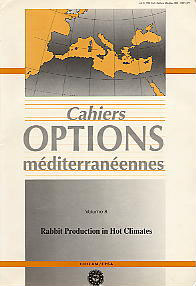| Article précédent | p. 189-196 | Article suivant |
Use of sawdust as a source of dietary fibre in rabbit diets
Twenty-eight New Zealand White 4 weeks weaned rabbits were divided into four groups of seven. Dietary treatments were 5, 10, 15 and 20 per cent sawdust. All diets were nearly isocaloric and isonitrogenous. The experiment lasted ten weeks and the chemical analysis of sawdust was: crude protein, 2.53 per cent; ether extract, 0.76 per cent; crude fibre, 60.26 per cent; nitrogen-free extracts, 24.53 per cent, and crude ash, 0.80 per cent. The values for total digestible nutrients (TDN) were 75.7, 66.0, 75.0 and 74.7 per cent; those for metabolizable energy (MEcal/kg) were 2.485, 2.150, 2.380, and 1.860; those for dry matter digestibility coefficients were 72.6, 62.0, 71.8 and 72.2 per cent; and those for organic matter were 73.8, 63.8, 72.4 and 72.0 per cent, respectively. Sawdust incorporation had a decreasing effect on body weight gains. However, feed efficiency ratios were poor with increasing its levels. Feed intake did not differ significantly. Weight gains were only significantly low on 20 per cent level (P less than 0.01). Also, 20 per cent group had a significant value for metabolizable energy (P less than 0.01). Diet containing 10 per cent sawdust showed a peculiar result which cannot be explained.
- [ Afficher ]
- [ Télécharger ]
- [ Exporter la citation ]
Vous pouvez télécharger la citation au format :
- [ Imprimer ]
-
Mots-clés
ALIMENTATION DES ANIMAUX, CROISSANCE, EFFICACITE ALIMENTAIRE, LAPIN, SCIURECiter cet article
Radwan M.S. Use of sawdust as a source of dietary fibre in rabbit diets. In : Baselga M. (ed.), Marai I.F.M. (ed.). Rabbit production in hot climates. Zaragoza : CIHEAM, 1994. p. 189-196. (Cahiers Options Méditerranéennes; n. 8). 1. International Conference of rabbit production in hot climates, 1994/09/06-08, Cairo (Egypt). http://om.ciheam.org/om/pdf/c08/95605293.pdf



